第3章 理想气体的性质与热力过程
- 格式:ppt
- 大小:2.32 MB
- 文档页数:75
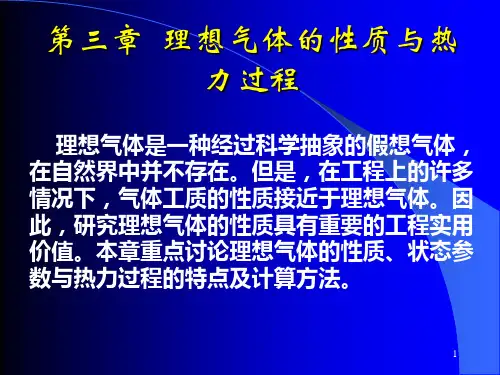


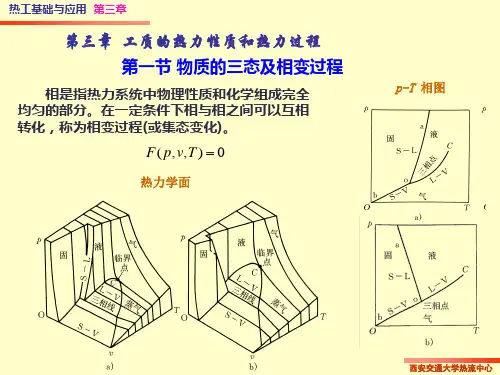
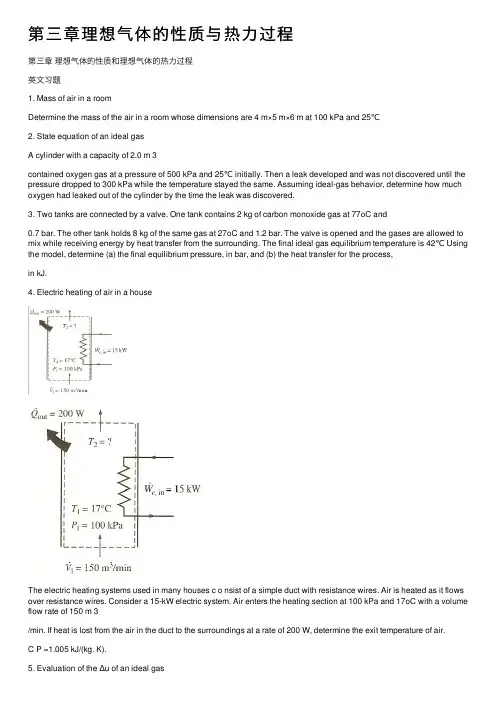
第三章理想⽓体的性质与热⼒过程第三章理想⽓体的性质和理想⽓体的热⼒过程英⽂习题1. Mass of air in a roomDetermine the mass of the air in a room whose dimensions are 4 m×5 m×6 m at 100 kPa and 25℃2. State equation of an ideal gasA cylinder with a capacity of 2.0 m 3contained oxygen gas at a pressure of 500 kPa and 25℃ initially. Then a leak developed and was not discovered until the pressure dropped to 300 kPa while the temperature stayed the same. Assuming ideal-gas behavior, determine how much oxygen had leaked out of the cylinder by the time the leak was discovered.3. Two tanks are connected by a valve. One tank contains 2 kg of carbon monoxide gas at 77oC and0.7 bar. The other tank holds 8 kg of the same gas at 27oC and 1.2 bar. The valve is opened and the gases are allowed to mix while receiving energy by heat transfer from the surrounding. The final ideal gas equilibrium temperature is 42℃ Using the model, determine (a) the final equilibrium pressure, in bar, and (b) the heat transfer for the process,in kJ.4. Electric heating of air in a houseThe electric heating systems used in many houses c o nsist of a simple duct with resistance wires. Air is heated as it flows over resistance wires. Consider a 15-kW electric system. Air enters the heating section at 100 kPa and 17oC with a volume flow rate of 150 m 3/min. If heat is lost from the air in the duct to the surroundings at a rate of 200 W, determine the exit temperature of air.C P =1.005 kJ/(kg. K).5. Evaluation of the Δu of an ideal gasAir at 300 K and 200 kPa is heated at constant pressure to 600 K. Determine the change in internal energy of air per unit mass, using (a) data from the air table, (b) the functional form of the specific heat, and (c) the average specific heat value.6. Properties of an ideal gasA gas has a density of 1.875 kg/m 3at a pressure of 1 bar and with a temperature of 15oC. A mass of 0.9 kg of the gas requires a heat transfer of 175 kJ to raise its temperature from 15oC to 250oC while the pressure of the gas remains constant. Determine (1) the characteristic gas constant of the gas, (2) the specific heat capacity of the gas at constant pressure, (3) the specific heat capacity of the gas at constant volume, (4) the change of internal energy, (5) the work transfer.7. Freezing of chicken in a boxCarbon2kg, 77oCarbon 8kg, 27oMonoxide C 0.7bar Monoxide C 1.2bar valve Tank 1Tank 2FIGURE 3-1FIGURE 3-2FIGURE 3-3A supply of 50 kg of chicken at 6℃ contained in a box is to be frozen to -18℃ in a freezer. Determine the amount of heat that needs to be removed. The latent heat of the chicken is 247 kJ/kg, and its specific heat is 3.32 kJ/kg.℃ above freezing and 1.77 kJ/kg.℃ below freezing. The container box is 1.5 kg, and the specific heat of the box material is 1.4 kJ/kg.℃. Also, the freezing temperature of chicken is -2.8℃.8. Closed- system energy balanceA rigid tank which acts as a perfect heat insulator and which has a negligible heat capacity is divided into two unequal partsA andB by a partition. Different amounts of the same ideal gas are contained in the two parts of the tank. The initial conditions of temperature T, pressure p, and total volume V are known for both parts of the tank. Find expressions for the equilibrium temperature T and pressure P reached after removal of the partition. Calculate the entropy change for A and B and the totalentropy change of the tank. Assume that Cv,m is constant,9. Thermal processes of an ideal gasAn air receiver has a capacity of 0.85 m 3and contains air at a temperature of 15℃ and a pressure of 275 kN/m 3. An additional mass of 1.7 kg is pumped into the receiver. It is then left until the temperature becomes 15℃ once again. Determine (1) the new pressure of the air in the receiver, (2) the specific enthalpy of the air at 15℃ if it is assumed that the specific enthalpy of the air is zero at 0℃. Take cp=1.005 kJ/kg.K, cc=0.715 kJ/kg.K.10. Air is compressed steadily by a reversible compressor from an inlet state of 100KPa and 300K toan exit pressure of 900 kPa. Determine the compressor work per unit mass for isentropic compression with k=1.4, (1) isentropic compression with k=1.4, (2) polytropic compression with n=1.3, (3) isothermal compression, and (4) ideal two-stage compression with intercooling with a polytropic exponent of 1.3.11. A rigid cylinder contains a “floating” piston, free to mo ve within the cylinder without friction. Initially,it divided the cylinder in half, and on each side of the piston the cylinder holds 1 kg of the same ideal gas at 20oC, and 0.2 MPa . An electrical resistance heater is installed on side A of the cylinder, and it is energized slowly to P A2=P B2=0.4 MPa. If the tank and the piston are perfect heat insulators and are of negligible heat capacity, cv=0.72 kJ/(kg·K). Calculate (1)the final temperatures, volumes of A,B sides, (2)the amount of heat added to the system by the resistor. (3)the entropy changes of A,B sides, (4)the total entropy change of the cylinder.⼯程热⼒学与传热学第三章理想⽓体的性质和热⼒过程习题1 理想⽓体的c p 和c V 之差及c p 和c V 之⽐是否在任何温度下都等于⼀个常数?习题0.20.1MPa 300K 0.01m 3AMPa 300K 0.01m 3BFIGURE 3-42如果⽐热容是温度t 的单调增函数,当t 2 >t 1时平均⽐热容2121,,00t t t t c c c 中哪⼀个最⼤?哪⼀个最⼩? 3如果某种⼯质的状态⽅程式遵循T R pv g ,这种物质的⽐热容⼀定是常数吗?这种物质的⽐热容仅是温度的函数吗? 4在p-v 图上画出定⽐热容理想⽓体的可逆定容加热过程,可逆定压加热过程,可逆定温加热过程和可逆绝热膨胀过程。
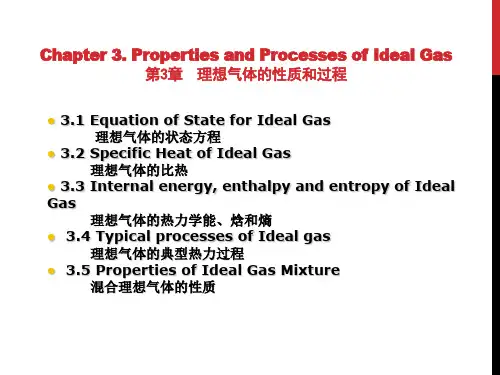
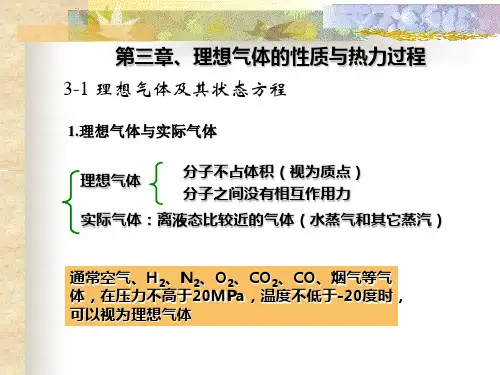
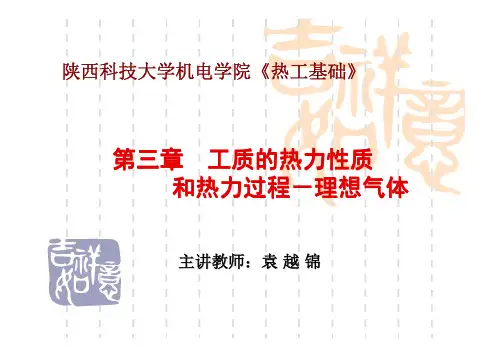
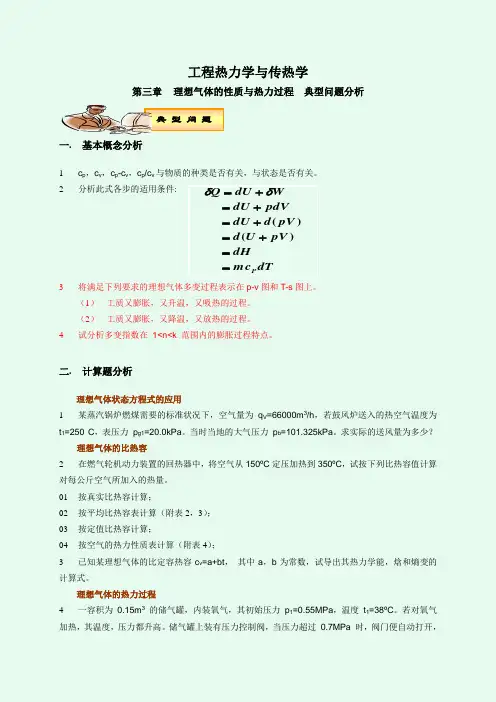
工程热力学与传热学第三章 理想气体的性质与热力过程 典型问题分析一. 基本概念分析1 c p ,c v ,c p -c v ,c p /c v 与物质的种类是否有关,与状态是否有关。
2 分析此式各步的适用条件:3将满足下列要求的理想气体多变过程表示在p-v 图和T-s 图上。
(1) 工质又膨胀,又升温,又吸热的过程。
(2) 工质又膨胀,又降温,又放热的过程。
4 试分析多变指数在 1<n<k 范围内的膨胀过程特点。
二. 计算题分析理想气体状态方程式的应用 1某蒸汽锅炉燃煤需要的标准状况下,空气量为 q V =66000m 3/h ,若鼓风炉送入的热空气温度为t 1=250°C ,表压力 p g1=20.0kPa 。
当时当地的大气压力 p b =101.325kPa 。
求实际的送风量为多少?理想气体的比热容 2在燃气轮机动力装置的回热器中,将空气从150ºC 定压加热到350ºC ,试按下列比热容值计算对每公斤空气所加入的热量。
01 按真实比热容计算;02 按平均比热容表计算(附表2,3); 03 按定值比热容计算;04 按空气的热力性质表计算(附表4); 3已知某理想气体的比定容热容c v =a+bt , 其中a ,b 为常数,试导出其热力学能,焓和熵变的计算式。
理想气体的热力过程 4一容积为 0.15m 3 的储气罐,内装氧气,其初始压力 p 1=0.55MPa ,温度 t 1=38ºC 。
若对氧气加热,其温度,压力都升高。
储气罐上装有压力控制阀,当压力超过 0.7MPa 时,阀门便自动打开,dTm c dHpV U d pV d dU pdV dU WdU Q P ==+=+=+=+=)()(δδ典 型 问 题放走部分氧气,即储气罐中维持的最大压力为 0.7MPa 。
问当罐中氧气温度为 285ºC 时,对罐中氧气共加入了多少热量?设氧气的比热容为定值。


第三章 气体的热力性质和热力过程思 考 题1. 理想气体的热力学能和焓只和温度有关,而和压力及比体积无关。
但是根据给定的压力和比体积又可以确定热力学能和焓。
其间有无矛盾?如何解释?答:其间没有矛盾,因为对理想气体来说,由其状态方程PV=RT 可知,如果给定了压力和比容也就给定了温度,因此就可以确定热力学能和焓了。
2. 迈耶公式对变比热容理想气体是否适用?对实际气体是否适用?答:迈耶公式p0v0c c R -=是在理想气体基础上推导出来的,因此不管比热是否变化,只要是理想气体就适用,而对实际气体则是不适用的。
3. 在压容图中,不同定温线的相对位置如何?在温熵图中,不同定容线和不同定压线的相对位置如何?答:对理想气体来说,其状态方程为:PV=RT ,所以,T 愈高,PV 值愈大,定温线离P-V 图的原点愈远。
如图a 中所示,T 2>T 1。
实际气体定温线的相对位置也大致是这样由定比热理想气体温度与熵的关系式2ln expp S R P C T c ++=可知,当S 一定时(C 2、R 、C p0都是常数)压力愈高,T 也愈高,所以在T-S 图中高压的定压线位于低压的定压线上,如图b 所示,P 2>P 1实际气体的定压线也类似的相对位置。
由定比热理想气体温度与熵的关系式1ln expv S R V C T c -+=可知,当S 一定时(C 1、R 、C v0都是常数)比容愈大,温度愈低,所以在T-S 图中大比容的定容线位于小比容的定容线下方,如图c 所示,v 2<v 1实际气体的定容线bT a P c T也有类似的位置关系。
4. 在温熵图中,如何将理想气体在任意两状态间热力学能的变化和焓的变化表示出来?答:对理想气体,任意两状态间内能变化21201v v u C dT q -∆==⎰,所以在温熵图中可用同样温度变化范围内定容过程所吸收的热量表示出来。
如同d ,定容线12’下的面积1342’1即表示1、2在状态间的热力学能变化12u -∆ 对理想气体来说,任意状态间的焓的变化21201p p h C dT q -∆==⎰,所以可用同样温度变化范围内定压过程所吸收的热量来表示。